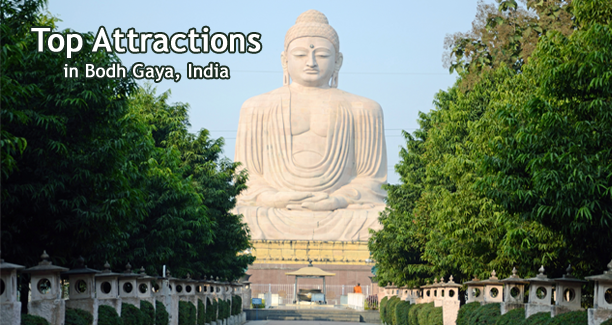One of the four sites of Buddhist Pilgrimage, Bodh Gaya, in the state of Bihar is considered to be the place where Gautama Buddha sat under the Mahabodhi or tree of enlightenment, and attained enlightenment. More than 1,850,000 tourists visit the spot every year. If you are a history and culture buff, or if you would like to more about one of the four initial centres of Buddhism in the world, visiting Bodh Gaya is a must. Have a look at some of the main attractions in Bodh Gaya.
Mahabodhi Temple
Constructed at the site where the Buddha attained enlightenment and where the Bodhi Tree originally stood, Mahabodhi Temple is said to have been built in the seventh century. It has been renovated and repaired many times, with the last repair work being carried out by the Archaeological Survey of India. The shrine is still shaped like the original Stupa, which was constructed by King Ashoka over which the Bodhi Temple had been built. The temple also consists of a colossal figure of the Buddha sitting in a meditative cross-legged position. There are no entry tickets for visiting the temple.
The Bodhi Tree
The Bodhi Tree, where the Buddha attained enlightenment, is the most significant relic in Buddhism. It is said that various small similar trees originated from the main tree. Story goes that for the first seven days of enlightenment, the Buddha meditated under this tree. The tree here is said to be the direct successor of the original one that once stood at this spot.
Great Buddha Statue
The spectacular idol of Gautama Buddha has a staggering height of 80 feet and is made of blocks of red granite and sandstone. It was established and inaugurated by the 14th Dalai Lama in 1989 and is one of the most visited sites in the area. The statue shows Gautama Buddha sitting on a giant lotus in a meditative position (Dhyana Mudra).
Animesh Lochana
Animesh Lochana, a Chaitya (Buddhist shrine) is said to be one of the places where Gautama Buddha spent the second week of enlightenment while looking at the Bodhi tree. It is believed that he stared at the tree without batting his eyelids as a gesture of gratitude for sheltering him for seven days. It is also said that he then spent seven days walking (Vihara) between the Animesh Lochana Chaitya and Bodhi tree. Presently it is called the Ratnachankrama, which means, the “Jewel Walk”. The place is one of the major tourist sites and attracts hordes of foreign as well as local tourists.







